When I started iDigHardware in 2009, one of my goals was to make it less painful to learn about doors and hardware, and in particular, the codes related to door openings. Although some of my more technical articles get a little detailed, I think I’ve accomplished my goal (do you agree?). Another result of this site is that AHJs are learning more about how door hardware works, which is fantastic!
One way I try to make the learning less painful is to share photos and talk about the applications from various perspectives, reinforcing what would otherwise be a lot of words in a code book. By showing how something doesn’t comply with the codes, I can help reinforce what is required. And poco a poquito, the code requirements get absorbed in our brains.
I’ve already shared a few posts on my recent trip to Colombia – one on openings in the floor, and two on the “egress doors” serving our AirBNBs in Santa Marta and Cali. I want to clarify that I’m not saying that these applications are not code compliant per the Colombian codes. I’m explaining how the US model codes and referenced standards would address these situations. To be honest, it’s not easy to find doors with such obvious “violations” in the US, which is a great thing!
During my trip, I was in the Bogotá airport four different times. Our first flight arrived at 5 a.m., so I was a little fuzzy and missed an opportunity with the delayed egress lock in the photos below. As you can see, the signage on the door refers to a button that needs to be pushed in order to start the 15-second timer. Where is the button? Who knows? I was still asleep. BUT – the point here is the US model codes require the following: An attempt to egress shall initiate an irreversible process that shall allow such egress in not more than 15 seconds when a physical effort to exit is applied to the egress side door hardware for not more than 3 seconds. Requiring building occupants to push a button on the wall would not be compliant with the US model codes. Delayed egress locks are typically either panic hardware with the delayed egress system built in, or electromagnetic locks with the delay that is activated by movement of the door.
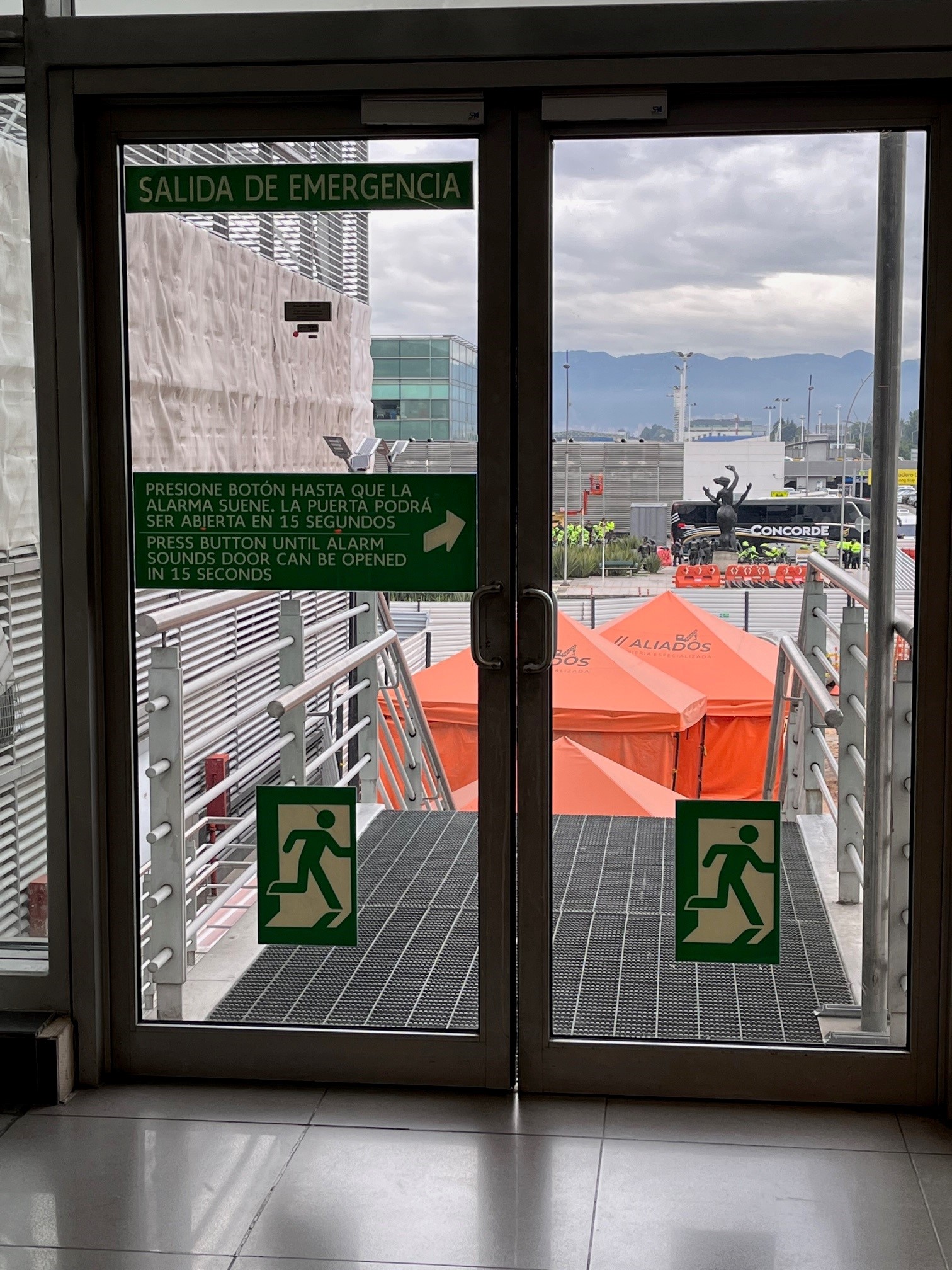

The next time we were in the airport, I saw a pair of doors with what looks like delayed egress panic hardware. At that moment I was playing a game with the kids where they try to identify whether a door has “real” Allegion hardware not. The interesting thing about this opening is that the language on the sign is exactly what is required by the US model codes – Push until alarm sounds, door can be opened in 15 seconds. But the sign also has the arrow that was on the first door’s sign, which referenced a button. IMO, the arrow just confuses things. Is it pointing to the pull station? A nonexistent button? Or is it indicating that you can exit through the door?
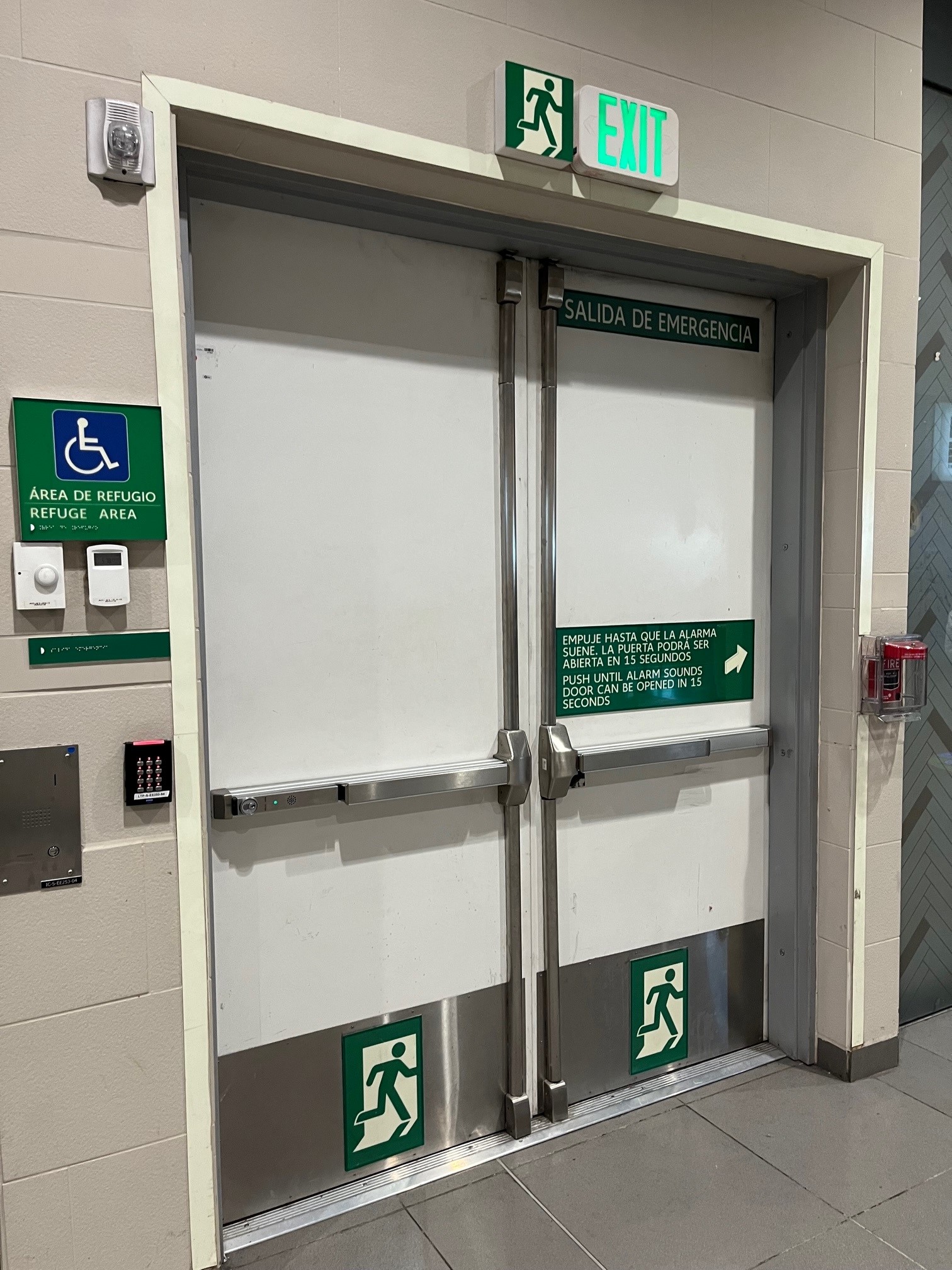
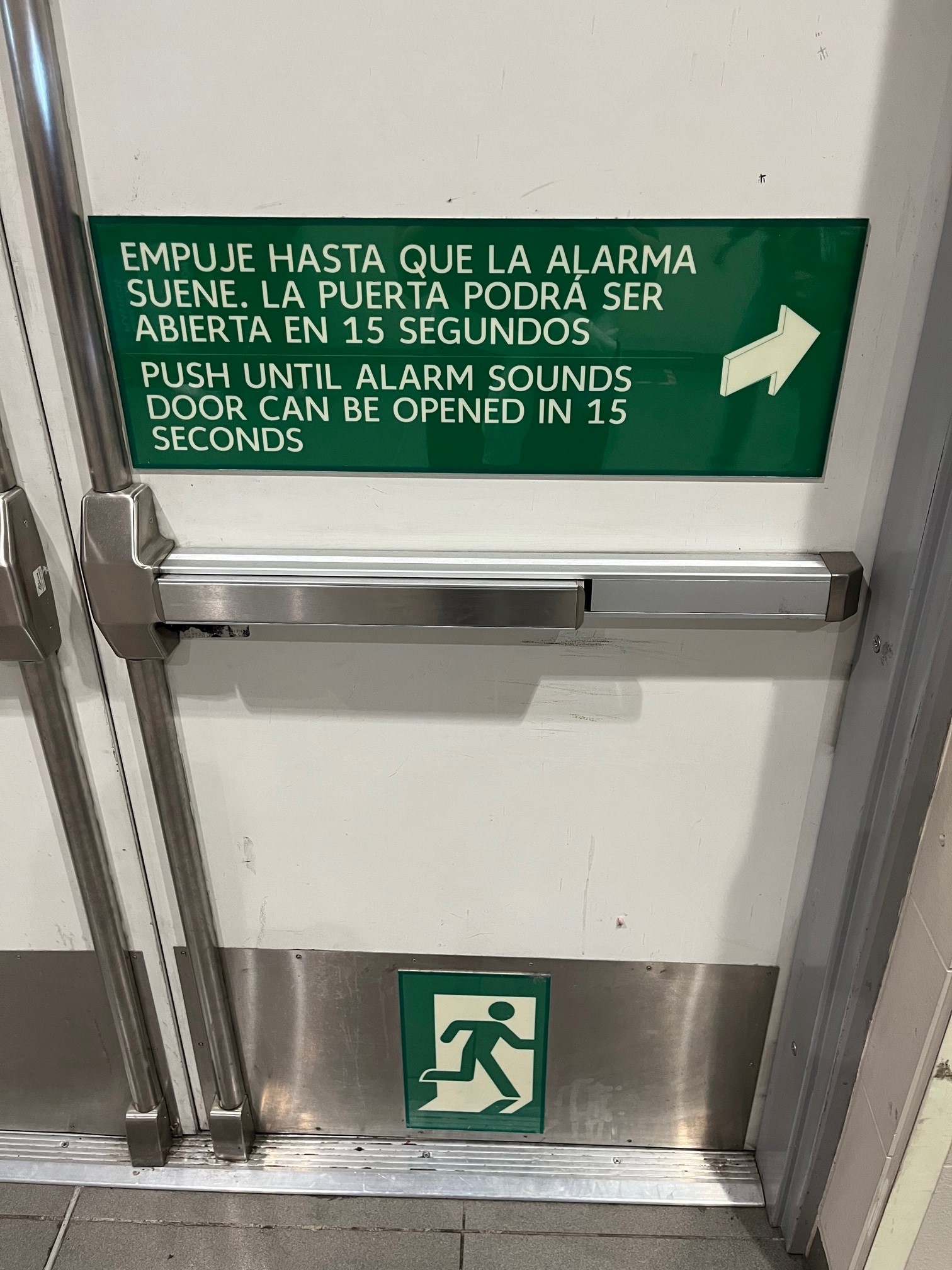
And finally, in on of the terminals we saw a REAL Von Duprin Chexit (protective film still installed), with the included signage installed on the door. As required by the I-Codes, the sign was above and within 12 inches of the door hardware (the NFPA code require the sign to be located on the egress side of the door adjacent to the release device).
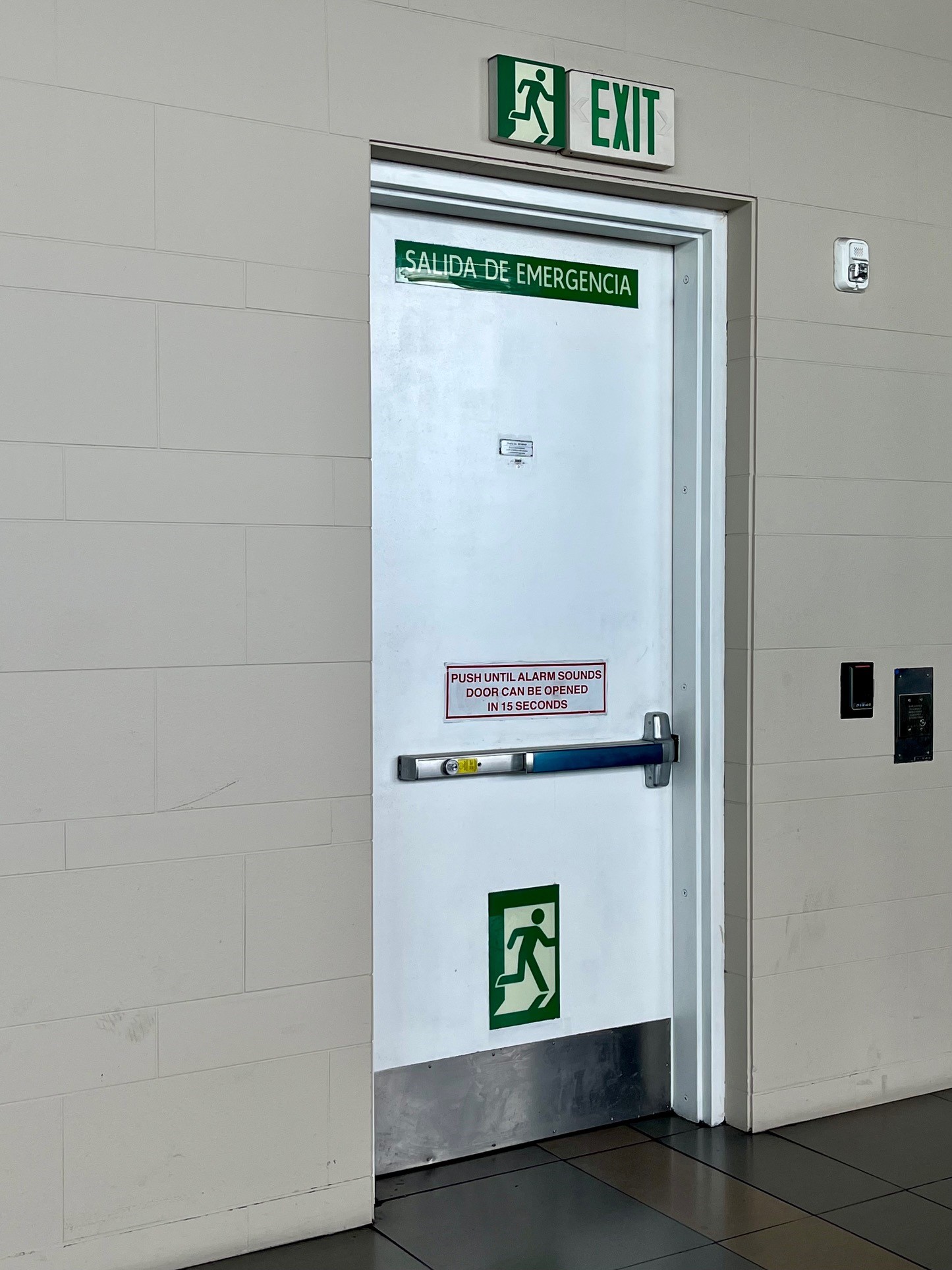
One more thing about delayed egress locks in airports…the model codes limit the use of these locks to certain occupancy types. They are not permitted by the I-Codes in assembly occupancies, with the exception of secondary egress doors in courtrooms (there is more on that in this article).
An airport terminal is considered an assembly occupancy, so technically the model codes would not allow delayed egress locks on the doors serving these spaces. BUT – in the US, regulations require delayed egress locks on certain airport doors for security reasons. Years ago, I asked an airport architect how this conflict was addressed, and he said that every delayed egress door serving their terminals had to be approved by the local AHJ. It’s kind of interesting that this hasn’t been modified in the I-Codes.
So…did you (painlessly) learn anything from this post? 🙂
You need to login or register to bookmark/favorite this content.

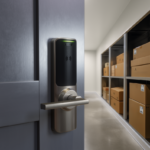



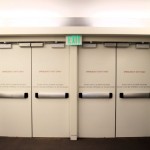
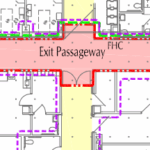


1. Airports worldwide, have their own door codes.
2. You do explain things/ codes/ hardware, in terms anyone can understand. Maybe you can help me with my children!
Love your trips, interesting what you are going to post.
I actually have a kid who is showing interest in the hardware business, so fingers crossed!
– Lori
Well
Will already have the answers !!
BS EN accepted a Break Glass or Push Button on the wall next to the exit door, Press or break those device should allow the release the exit door for instant.
In order to exit through the door, there needs to be a means to release the
electronic lock. Where electric strikes or electrically activated lever sets are
specified then a manual lever handle may suffice. For ‘read out’ situations,
where access control is required to both sides of a door, a second reader will
be required. In other instances, one of the following release mechanisms will
be needed.
REQUEST TO EXIT BUTTON
If a door does not have a mechanical means of exit, e.g. a lever handle or push
bar, an electronic method is used, known as a ‘Request to Exit’ (RTE) button. There
are a range of different shapes and sizes but all have the same function. When
pushed they send a signal to the device controlling the door which then releases
the locking mechanism allowing exit.
First reply – signage –
“Or is it indicating that you can exit through the door?”
The arrow ‘looks’ 3D, kind of like “this way out”? That’s how I see it, and the 2nd pair pictured looks like it’s on the wrong leaf.
Second reply –
Do you help explaining how/what/is? Yes, I’m only an installer, no credentials per se…….well, except 35+ years of installs…..And I’ve been following you for many years here, the resources and code changes help me do my thing out in the field. Several years ago, 4-5 years now, I was on a hospital job, the company supplying doors/hardware had sent all SVR with bottom rods/latches, as per the ADA 2018 code, no projection on the bottom of the door within 10″ AFF.
I did not install bottom rods, the supplier-owner/AHC asked why, and I called out the code, so the job super and the architect also agreed with me, and supplier-owner was mad, cause a lonely ole installer caught one on him.
I’ve learned here, I’ve sent others here to learn, so feel comfortable that your work is not going to waste. Thank you.
Thanks Bob! I’m so glad the site is helpful! 🙂
– Lori
Regarding the duplicate exit signs (symbol and text) above the doors: that seems to have been a workaround to older IBC versions. Contrary to popular belief the 2021 and newer IBC allows symbol exit signs in many cases. (The ICC BSJ ran article about this a couple months ago.)
Regarding delayed egress in airports: Is the timer adjustable during installation? Fort Myers uses a 6-second delay (posted on the signage) instead of a 15-second one.